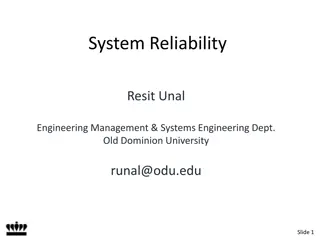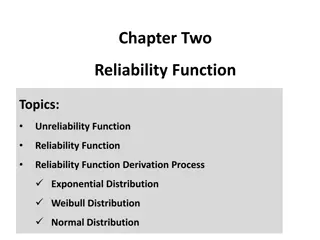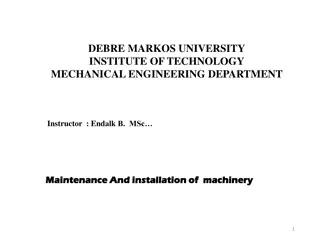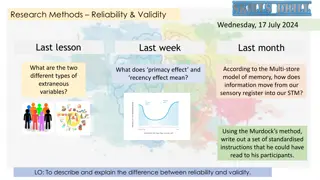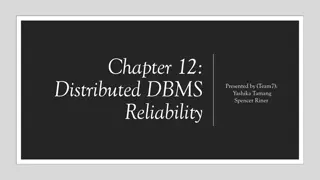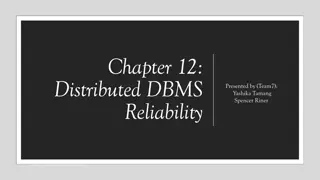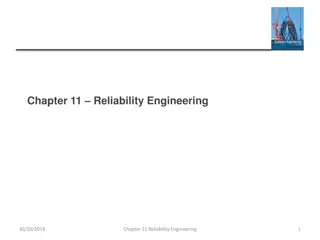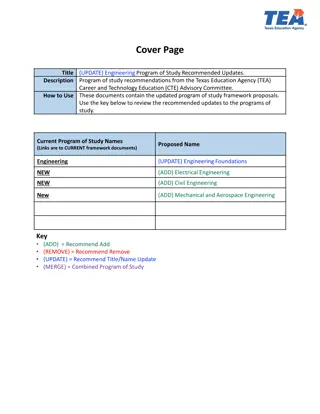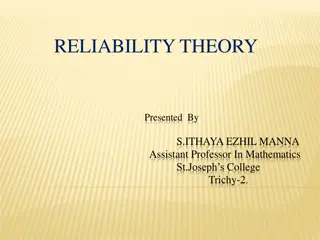Robust Design and Reliability-Based Design in Engineering
Robust design ensures a product can function effectively despite variations or uncertainties introduced during manufacturing, environmental conditions, or user interactions. This approach focuses on minimizing the impact of uncertainties without removing their causes, through altering design variables to enhance performance resilience. The concept of robustness emphasizes insensitivity to uncertainty, enabling products to withstand diverse conditions without compromising functionality or quality. This design strategy is illustrated through examples like tile manufacturing, demonstrating cost-effective solutions that enhance product reliability and consistency.
Download Presentation

Please find below an Image/Link to download the presentation.
The content on the website is provided AS IS for your information and personal use only. It may not be sold, licensed, or shared on other websites without obtaining consent from the author.If you encounter any issues during the download, it is possible that the publisher has removed the file from their server.
You are allowed to download the files provided on this website for personal or commercial use, subject to the condition that they are used lawfully. All files are the property of their respective owners.
The content on the website is provided AS IS for your information and personal use only. It may not be sold, licensed, or shared on other websites without obtaining consent from the author.
E N D
Presentation Transcript
Robust Design and Reliability-Based Design ME 4761 Engineering Design 2015 Spring Xiaoping Du
Outline Definition of robustness Introductory examples Statistics How to achieve robustness Examples Related methodology: reliability-based design Conclusions 2
Robust Design If a design can work properly even when subjected to variation, it is robust. Variation (uncertainty) may be introduced by manufacturing processes environment parts from outside suppliers end user 3
Robustness The robustness of a product is the ability that its performances are not affected by the uncertain inputs or environment conditions (noises). Robustness is insensitivity to uncertainty. A robust product can work under large uncertainties. 4
Variation (Uncertainty) Piece-to-piece variation Customer usage and duty cycle Human errors Model inaccuracy Uncertainty Knowledge Complete ignorance Present state of knowledge Complete knowledge 5
An Example: Cantilever Beam P A A - A C B h1 h2 b1 A l2 l1 b2 The material strength S + 6 ( P l ) l = The maximum stress 1 2 max S 2 2 2 b h = Factor of safety 1 F s max Reality: everything is uncertain Load: P=(2001.4, 1531.3, 2534.6, .) kN Yield strength: Sy=(120.5, 101.3, 131.2, 170.9, ) MPa Dimension: h1= 100 0.01 mm Dimension: b1= 50 0.01 mm, . 6
Principle of Robust Design Minimize the effect of uncertainty (variation) without eliminating the cause of uncertainty. How? By changing design variables to make the performance not sensitive to uncertainty. 7
Example: Tile Manufacturing Output: Tile dimensions Problem: Large variability in dimensions Uncertainty source: Huge variation in temperature Possible solutions Screening Redesign the kiln Too expensive Robust design solution Do not control the temperature Change design variables: increasing the lime content of the clay from 1% to 5% Inexpensive Phadke: Quality Engineering Using Robust Design, 1989 8
Benefits of Robust Design Product performance insensitive to material variation > use of low grade material and components Product performance insensitive to manufacturing variation -> reduced labor and manufacturing cost Product performance insensitive to the variation in operating environment -> higher reliability and lower operation cost 9
How Do We Quantify Uncertainty? Support we have 100 measurements for ? = ?1 (99.99, 100.08, ,100.05) mm Average Dispersion 1 100 1 n = = Mean 99.96 X x = 2 Standard deviation ( ) x X i 100 i 100 1 = 1 i = 1 i Histogram Probability density (distribution) 10
Probability Distribution Design 1 ?1, ?1 Mean average Standard deviation (std) dispersion around the average or amount of variation Two designs with two performance variables ?1= ?2, ?2> ?1 Designs 1 and 2 have the same average performance The variation of Design 1 is smaller Design 1 is more robust ?1 Design 2 ?2, ?2 ?2 11
TV Example In 1970s, Americans showed a preference for television sets made by Sony-Japan over those made by Sony-USA. The color density was a major performance. Target tolerance = m 5. Sony-Japan sets: 0.3% defective sets (outside the tolerance limits) Sony-USA sets: virtually NO sets outside the tolerance limits. Why? 12 Phadke: Quality Engineering Using Robust Design, 1989
TV Example Sony-USA: Uniform distribution, = 2.89 Sony-Japan: Normal distribution, = 1.67, and most of the sets are grade A. 13 Phadke: Quality Engineering Using Robust Design, 1989
How to Evaluate Robustness? X Analysis Model Y=g(X) Y Traditional design m:target, : tolerance L(y): quality loss = 0 within the tolerance limits Robust design Taguchi s quality loss ($) ?(?) = ?(? ?)2, k: constant quality loss = 0 only at m L(y) m- m+ y m L(y) y m+ m- m 14
Expected Quality Loss Expected (average) quality loss E(?) = ?[ ? ?2+ ?? Minimizing E ? will bring the average performance to the target and reducing variation ?? simultaneously. 2] Final design Initial design 15
Robust Design Increasing average performance Decreasing variation 16
Other Types of Quality Loss What we ve discussed is the nominal-the-better type The smaller-the-better type cost, stress, energy consumption L(y) 0 y L(y) The larger-the-better type life, reliability, strength, efficiency 0 y 17
How to Select Design Variables to Achieve Robustness? Performance ? = ? ?1,?2, ,?? Design variables ? = ?? ? = 1,2, ,? are independent ?1, ?2, , ?? 18
Parameter Design Averageperformance ? = ? ?1, ?2, , ?? Taylor expansion series ? ? + ?1(?1 ?1) + ?2(?2 ?2) + + ??(?? ??) Sensitivity Y ?? ??? at ? ? = 1,2, ,? Std ??= ?1 Change ? (not reduce ??) to minimize E(?) = ?[ ? ?2+ ?? ??= 2?1 2+ ?2 2?2 2+ + ?? 2?? 2 X 0 X Taylor expansion 2] 19
More about Sensitivity Insensitive (robust) Output y Sensitive Input x 20
Example: Robust Mechanism Synthesis Requirements: ? = ?1= 350 mm when ? = 10 ? = ?2= 250 mm when ? = 60 Uncertainties in a, b, and e ??= 2mm, ??= 2mm,??= 3mm Design variables ?, ?, ? B b a A e C N N 21
Results ) sin Transmission angle > 45 ( 2 = + e a + 2 cos s a b 2 2] ?[ ?? ??2+ ??? Minimize ?=1 Method Deterministic Design Robust Design ? (mm) 119.6 136.6 ?(mm) 241.3 216.8 ?(mm) 45.0 0.0 ? (? = 10 ) (mm) 350 350 ? (? = 60 ) (mm) 250 250 (? = 10 ) (mm) 2.9 2.8 (? = 60 ) (mm) 3.5 3.1 22
Example 2 - Piston Engine Robust Design Liner + min w w f Slap noise G - Friction 1 2 f f x . . st P G 7 0.99 Baseline 54.5 dB 2.04 dB 0.65 Optimal 54.2 dB 0.76 dB 0.99 Mean of f Std of f Prob 23
Other Method Operating Window Methods Developed by Xerox. The operating window is the set of conditions under which the system operates without failure. A wider window can accommodate larger uncertainties. Robustness is achieved by making the operating window larger. 24
Related Issue: Reliability (R) The ability of a product performing its intended function ? = probability of no failure ? = Pr{design points falling into safe region} ? = Pr{strength > stress} ? = Pr{factor of safety > 1} x2 Failure region Boundary Deterministic optimal point Safe region x1 25
Reliability vs. Robustness Everyday fluctuations around the mean deterioration, degradation, quality loss Extreme events at tails failure, catastrophe Reliability issue Motherboard failure Broken hard disk Robustness issue Overheating Noise 26
How to Design for Reliability? Conceptual design Failure mode and effects analysis (FMEA) (IDE 20 & ME 161) Parameter design Reliability-based design x2 x2 Failure Region Failure Region Safe Region Safe Region x1 x1 27
Software Tools iSIGHT MSC Robust Design Robust Design for Whirlpool Products http://www.mscsoftware.com/success/details.cfm ?Q=285&sid=282 Ansys Monte Carlo Simulation ADAMS Design of Experiments 28
Conclusions Robust design -> insensitivity to uncertainties Insensitive to material variations-> use of low grade materials and components -> low material cost Insensitive to manufacturing variations -> no tightened tolerances -> low manufacturing and labor cost Insensitive to variations in operation environment -> low operation cost Robust design -> increased performance, quality, and reliability at reduced cost Robustness and reliability can be built into products during early stages of design. 29
More Information Visit the website of Engineering Uncertainty Repository at http://www.mst.edu/~dux/repository. Contact me Toomey Hall 272 dux@mst.edu 30





